
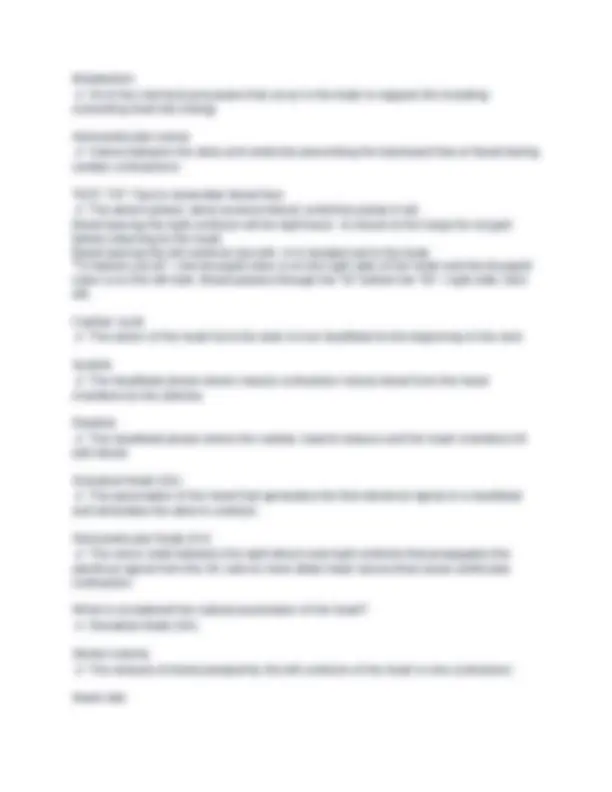

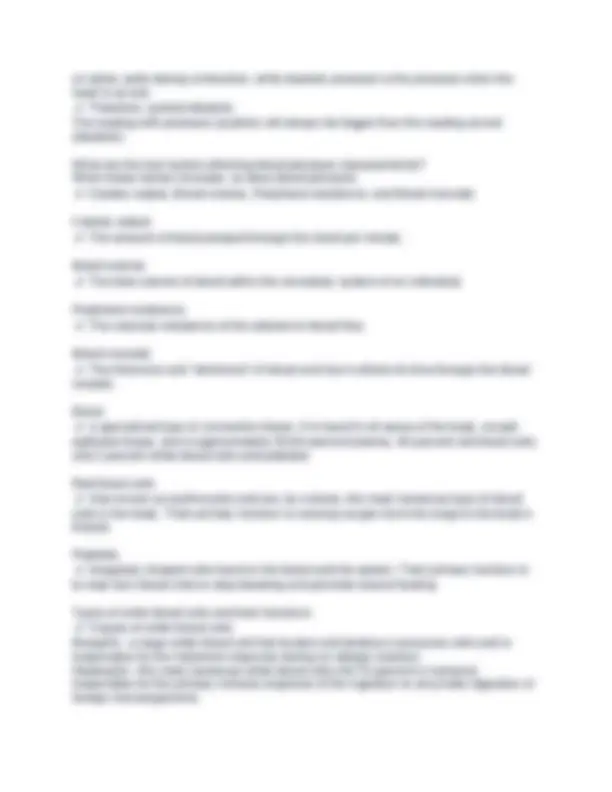
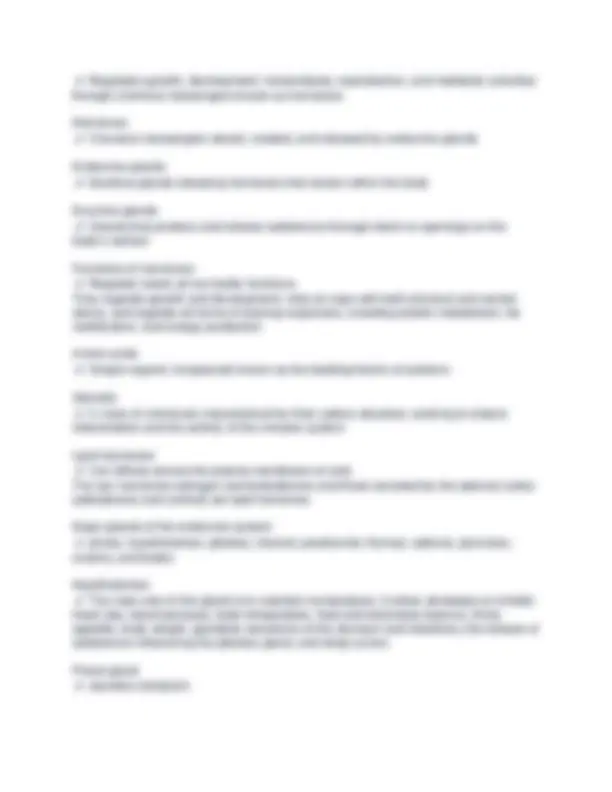
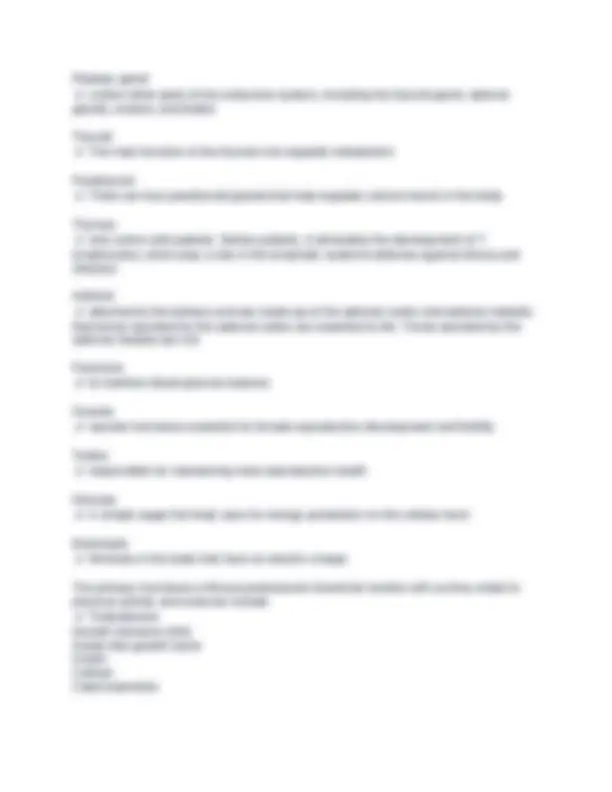
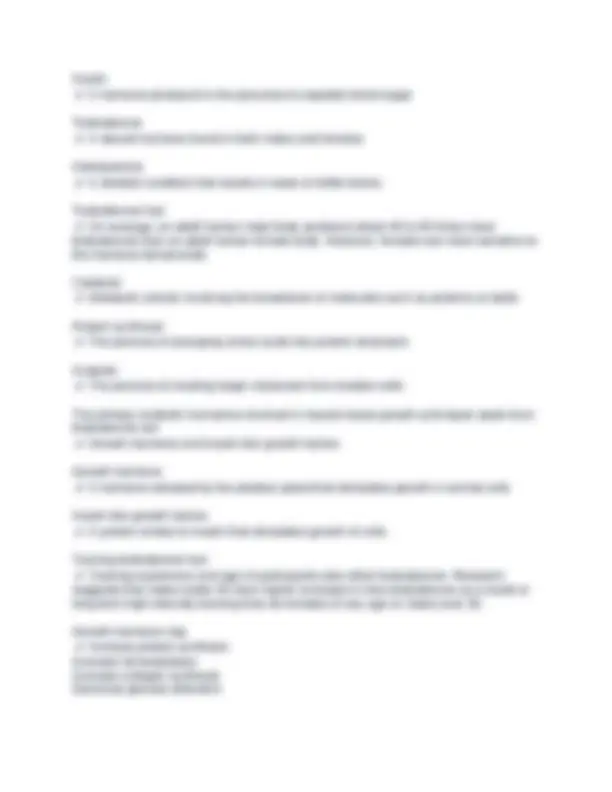
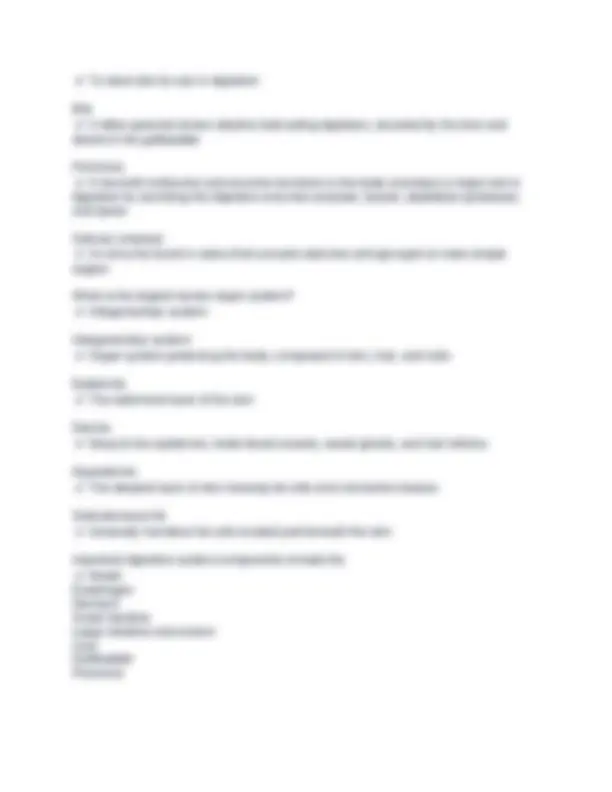


Study with the several resources on Docsity

Earn points by helping other students or get them with a premium plan


Prepare for your exams
Study with the several resources on Docsity

Earn points to download
Earn points by helping other students or get them with a premium plan
Community
Ask the community for help and clear up your study doubts
Discover the best universities in your country according to Docsity users
Free resources
Download our free guides on studying techniques, anxiety management strategies, and thesis advice from Docsity tutors
ISSA CPT Chapter 4 Supporting Systems Questions with Answers latest 2025
Typology: Exams
1 / 13

This page cannot be seen from the preview
Don't miss anything!








What 3 human body systems work together to generate human body movement? ✔ Nervous system, Muscular system, Skeletal system Which 3 systems have a direct impact on the responses and adaptations to physical activity and exercise. ✔ Respiratory system, Circulatory system, Endocrine system Circulatory System ✔ A closed system circulating blood through the body, consisting of the heart, blood vessels, and blood. Closed system ✔ A physical system that does not allow for the movement of matter into or out of the system. What is the primary function of the circulatory system? ✔ To facilitate the exchange of oxygen and carbon dioxide, thereby transporting oxygen from the lungs to the body tissues and moving carbon dioxide from the tissues to the lungs to be excreted T/F: The circulatory system is a closed system ✔ True Arteries ✔ Blood vessels carrying oxygenated blood away from the heart and to the tissues. Veins ✔ Blood vessels carrying blood toward the heart to remove waste and pick up more oxygen. Capillaries ✔ Fine-branching blood vessels forming a network between the arterioles and venules, where transport of nutrients and oxygen or carbon dioxide occurs on a microscopic scale. What are the main structures of the cardiovascular system? ✔ Blood vessels and the heart
Arterioles ✔ The smaller branches of the arteries leading to the capillaries. Venules ✔ The small branches of the veins gathering blood from the capillaries. What is another name that the heart is referred to? ✔ Myocardium Atrium ✔ One of the two upper cavities of the heart passing blood to the ventricles. The plural is "atria." Has a left and a right Ventricle ✔ One of the two lower cavities of the heart passing blood to the body or to the lungs. Has a left and a right Pulmonary Arteries ✔ Blood vessels moving blood from the heart to the lungs. Pulmonary Veins ✔ Blood vessels returning oxygenated blood to the heart from the lungs. Aorta ✔ The main artery in the body that supplies oxygenated blood to the circulatory system. Pulmonary circulation ✔ The blood flow between the heart and the lungs. Systemic Circulation ✔ The blood flow between the heart and the rest of the body. About how many times does the heart beat a day? ✔ About 100,000 times About how many gallons of blood is pumped around the body per day? ✔ Roughly 2,000 gallons Superior Vena Cava ✔ The blood vessel moving blood from the upper body and head to the heart Inferior vena cava ✔ The blood vessel moving blood from the lower body to the heart
✔ The number of heartbeats per minute. TEST TIP: The American Heart Association norms state that resting heart rates can range between 60 beats per minute (bpm) and 100 bpm, depending on the person. A more conditioned individual will have a lower resting heart rate in general. ✔ Comparison assuming both individuals were at complete rest for 24 hours Conditioned person: 60 bpm x 60 minutes = 3,600 beats per hour (bph) 3,600 bph x 24 hours = 86,400 beats per day (bpd) Deconditioned person: 80 bpm x 60 minutes = 4,800 bph 4,800 bph x 24 hours = 115,200 bpd Over the life of the individual, the additional work and strain on the heart of a deconditioned person can be detrimental. Pulse ✔ A rhythmical throbbing of the arteries as blood is propelled through them. Where can a pulse be found? ✔ Anywhere an artery is close to the surface of the skin and rests against something solid like a bone, tendon, or ligament. The most common sites to take a pulse are at the radial artery in the wrist and the carotid artery in the neck. Blood pressure ✔ The force of blood pushing against the walls of the arteries during the two phases of the cardiac cycle. What is the normal blood pressure according to the American Heart Association? ✔ Anything less than or equivalent to 120/80 mm Hg Systolic ✔ The pressure in blood vessels when the heart beats (ventricular contraction) Diastolic ✔ The pressure in blood vessels when the heart rests (ventricular filling) Hypotension ✔ Low blood pressure measuring 90/60 mm Hg or lower Hypertension ✔ High blood pressure measuring more than 140/90 mm Hg TEST TIP: To remember which number is where in a blood pressure measurement, remember that the heart has to contract before it relaxes. Systolic pressure is pressure
on artery walls during contraction, while diastolic pressure is the pressure when the heart is at rest. ✔ Therefore, systolic/diastolic. The reading with pressure (systolic) will always be bigger than the reading at rest (diastolic). What are the four factors affecting blood pressure measurements? When these factors increase, so does blood pressure. ✔ Cardiac output, Blood volume, Peripheral resistance, and Blood viscosity Cardiac output ✔ The amount of blood pumped through the heart per minute. Blood volume ✔ The total volume of blood within the circulatory system of an individual. Peripheral resistance ✔ The vascular resistance of the arteries to blood flow. Blood viscosity ✔ The thickness and "stickiness" of blood and how it affects its flow through the blood vessels. Blood ✔ a specialized type of connective tissue. It is found in all areas of the body, except epithelial tissue, and is approximately 55-60 percent plasma, 40 percent red blood cells, and 2 percent white blood cells and platelets. Red blood cells ✔ Also known as erythrocytes and are, by volume, the most numerous type of blood cells in the body. Their primary function is carrying oxygen from the lungs to the body's tissues Platelets ✔ Irregularly shaped cells found in the blood and the spleen. Their primary function is to help form blood clots to stop bleeding and promote wound healing Types of white blood cells and their functions ✔ 5 types of white blood cells Basophil—a large white blood cell that locates and destroys cancerous cells and is responsible for the histamine response during an allergic reaction. Neutrophil—the most numerous white blood cells (40-70 percent in humans) responsible for the primary immune response of the ingestion or enzymatic digestion of foreign microorganisms.
Regulating the pH of blood Respiration ✔ The intake of oxygen and subsequent release of carbon dioxide in an organism. Pulmonary ventilation ✔ The process of exchange of air between the lungs and the ambient air. Respiratory system ✔ Network of organs and tissues that help you breathe Lymphatic system ✔ A group of organs, vessels and tissues that protect you from infection and keep a healthy balance of fluids throughout your body Inspiration ✔ Breathing air into the lungs Expiration ✔ Breathing air out of the lungs Diaphragm ✔ The dome-shaped muscle that separates the lungs and pleural cavity from the abdomen Diffusion ✔ The passive movement of molecules or particles along a concentration gradient or from regions of higher concentration to regions of lower concentration Thoracic cavity ✔ The chest cavity enclosed by the ribs, sternum, and spinal column Intra-Alveolar pressure ✔ The pressure within the alveoli that changes throughout respiration External respiration ✔ The exchange of gases between the lungs and the blood Internal respiration ✔ The process of diffusing oxygen from the blood into the interstitial fluid and into the cells Endocrine system
✔ Regulates growth, development, homeostasis, reproduction, and metabolic activities through chemical messengers known as hormones Hormones ✔ Chemical messengers stored, created, and released by endocrine glands Endocrine glands ✔ Ductless glands releasing hormones that remain within the body Exocrine glands ✔ Glands that produce and release substances through ducts or openings on the body's surface Functions of hormones ✔ Regulate nearly all our bodily functions They regulate growth and development, help us cope with both physical and mental stress, and regulate all forms of training responses, including protein metabolism, fat mobilization, and energy production Amino acids ✔ Simple organic compounds known as the building blocks of proteins Steroids ✔ A class of chemicals characterized by their carbon structure, working to reduce inflammation and the activity of the immune system Lipid hormones ✔ Can diffuse across the plasma membrane of cells The sex hormones estrogen and testosterone and those secreted by the adrenal cortex (aldosterone and cortisol) are lipid hormones Major glands of the endocrine system ✔ pineal, hypothalamus, pituitary, thyroid, parathyroid, thymus, adrenal, pancreas, ovaries, and testes Hypothalamus ✔ The main role of this gland is to maintain homeostasis. It either stimulates or inhibits heart rate, blood pressure, body temperature, fluid and electrolyte balance, thirst, appetite, body weight, glandular secretions of the stomach and intestines, the release of substances influencing the pituitary gland, and sleep cycles. Pineal gland ✔ secretes melatonin
Insulin ✔ A hormone produced in the pancreas to regulate blood sugar Testosterone ✔ A steroid hormone found in both males and females Osteoporosis ✔ A skeletal condition that results in weak or brittle bones Testosterone fact ✔ On average, an adult human male body produces about 40 to 60 times more testosterone than an adult human female body. However, females are more sensitive to the hormone behaviorally Catabolic ✔ Metabolic activity involving the breakdown of molecules such as proteins or lipids Protein synthesis ✔ The process of arranging amino acids into protein structures Anabolic ✔ The process of creating larger molecules from smaller units The primary anabolic hormones involved in muscle tissue growth and repair aside from testosterone are ✔ Growth hormone and insulin-like growth factors Growth hormone ✔ A hormone released by the pituitary gland that stimulates growth in animal cells Insulin-like growth factors ✔ A protein similar to insulin that stimulates growth of cells Training testosterone fact ✔ Training experience and age of participants also affect testosterone. Research suggests that males under 30 have higher increases in free testosterone as a result of long-term high-intensity training than do females of any age or males over 30. Growth hormone may ✔ Increase protein synthesis Increase fat breakdown Increase collagen synthesis Decrease glucose utilization
What time of day is growth hormones highest at? ✔ Highest levels are at night TEST TIP: Insulin ✔ Insulin helps move glucose into the cells. Insulin = IN the cells Cortisol ✔ A catabolic hormone released in response to physical and emotional stress What types of exercise intensity can reduce blood cortisol levels instead of increasing them? ✔ Moderate to low intensity exercise Ketone bodies ✔ Molecules released by the liver in starvation states for an alternate energy source Ketosis ✔ A metabolic process that occurs when the body does not have enough carbohydrates for energy; the liver metabolizes fatty acids to produce ketones as a replacement energy source TEST TIP: Cortisol ✔ Remember that cortisol can be good or bad based on how long it remains elevated. Short-term cortisol elevation: Increases blood sugar (glucose) levels Enhances the brain's use of glucose Reduces inflammation Reduces unnecessary bodily functions during the fight-or-flight response Extended-duration cortisol elevation: Increases appetite Increases blood pressure Promotes weight gain Contributes to type 2 diabetes Which hormones are "fight or flight" ✔ Epinephrine, Norepinephrine, and Dopamine Catecholamines ✔ Hormones released by the adrenal glands into the blood as a result of stress TEST TIP: Exocrine glands ✔ Remember that EXOcrine glands secrete substances that EXIT the body, while ENDOcrine glands produce substances that remain within the body. Examples of exocrine glands
✔ To store bile for use in digestion Bile ✔ A bitter greenish-brown alkaline fluid aiding digestion, secreted by the liver and stored in the gallbladder Pancreas ✔ It has both endocrine and exocrine functions in the body and plays a major role in digestion by secreting the digestive enzymes amylase, trypsin, peptidase (protease), and lipase Salivary amylase ✔ An enzyme found in saliva that converts starches and glycogen to more simple sugars What is the largest human organ system? ✔ Integumentary system Integumentary system ✔ Organ system protecting the body; composed of skin, hair, and nails Epidermis ✔ The outermost layer of the skin Dermis ✔ Deep to the epidermis; holds blood vessels, sweat glands, and hair follicles Hypodermis ✔ The deepest layer of skin housing fat cells and connective tissues Subcutaneous fat ✔ Generally harmless fat cells located just beneath the skin Important digestive system components include the ✔ Mouth Esophagus Stomach Small intestine Large intestine and rectum Liver Gallbladder Pancreas